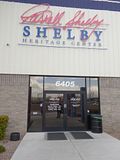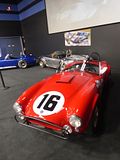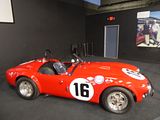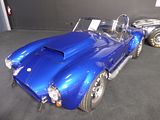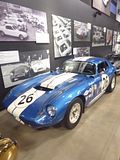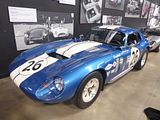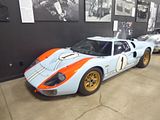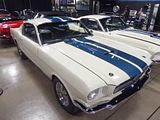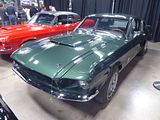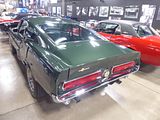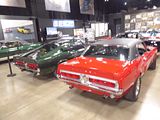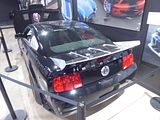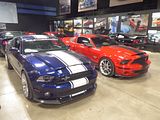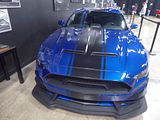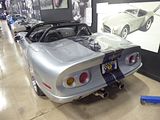Shelby American Inc is an American high performance automobile company founded by driver Carroll Shelby. The Shelby American name has been used by several legally distinct corporations founded by Shelby since his original shop in Venice, California began operation in 1962. The current iteration is a wholly owned subsidiary of Carroll Shelby International, Inc. (Expert Market: CSBI), a holding company formed in 2003. Carroll Shelby International’s other wholly owned subsidiary is Carroll Shelby Licensing, which licenses the name and trademarks associated with Shelby to other companies (including Shelby American). Shelby American was the first automobile manufacturer in the state of Nevada. Shelby American manufactures component automobiles, including replicas of the small-block and large-block AC Cobras, the Shelby GT350 and the GT500 Super Snake. Since 2005, Shelby American has released new models each year. Last time I visited the Shelby facility, it was located north of the ci right by the racetrack, but needing more space, the company moved in 2013 to a new site which is located very close to the airport. The site contains both the production facility and a heritage center, as well as sizeable shop selling lots of Shelby related merchandise. The Heritage Center is free to visit, and open every day, though it is worth checking if there is any event on which might mean it is not open or only partially open, as I found out when I first went along. As it was so close to my hotel, I made a repeat visit a few days later, and was able to see the whole of the museum display. If you are expecting a really swish museum, then you might be disappointed, as the cars – of which there are around 20 on show, at any one time – are simply parked up. The display and the lighting proved to be quite a challenge, as you will see in this report, too, but there are some nice cars, well worth seeing. Shelby does have far more cars than these in their possession, so if you were to go for a second time, you may well see some different models. This is what I found at the time of my visit in April 2023:
AC Cobra 427SC: The AC Cobra, sold in the United States as the Shelby Cobra and AC Shelby Cobra, is a sports car manufactured by British company AC Cars, with a Ford V8 engine. It was produced intermittently in both the United Kingdom and later the United States since 1962. Like many British manufacturers, AC Cars had been using the Bristol straight-6 engine in its small-volume production, including its AC Ace two-seater roadster. This had a hand-built body with a steel tube frame, and aluminium body panels that were made using English wheeling machines. The engine was a pre-World War II design by BMW which by the 1960s was considered dated. In 1961 Bristol decided to cease production of its engine. In September 1961, American retired race car driver and automotive designer Carroll Shelby wrote to AC asking if they would build him a car modified to accept a V8 engine. Bristol engines for the AC Ace two-seater sports car had recently been discontinued so AC agreed, provided a suitable engine could be found. Shelby went to Chevrolet to see if they would provide him with engines, but not wanting to add competition to the Corvette, Chevrolet declined. However, Ford wanted a car that could compete with the Corvette and they happened to have a brand new engine which could be used in this endeavour: the Windsor 3.6-litre (221 cu in) engine – a new lightweight, thin-wall cast small-block V8. Ford provided Shelby with two engines. AC exported completed, painted, and trimmed cars (less engine and gearbox) to Shelby who then finished the cars in his workshop in Los Angeles by installing the engine and gearbox and correcting any bodywork flaws caused by the car’s passage by sea. A small number of cars were also completed on the East Coast of the US by Ed Hugus in Pennsylvania, including the first production car; CSX2001. The first 75 Cobra Mk1 models (including the prototype) were fitted with the 4.3 L (260 cu in). The remaining 51 Mk1 models were fitted with a larger version of the Windsor Ford engine, the 4.7-litre (289 cu in) V8. In late 1962, Alan Turner, AC’s chief engineer, completed a major design change of the car’s front end to accommodate rack and pinion steering while still using transverse leaf spring suspension (with the leaf spring doubling as the upper suspension link). The new car entered production in early 1963 and was designated Mark II. The steering rack was borrowed from the MGB while the new steering column came from the VW Beetle. About 528 Mark II Cobras were produced from 1963 to the summer of 1965 (the last US-bound Mark II was produced in November 1964). A new chassis was required, developed, and designated Mark III. The new car was designed in cooperation with Ford in Detroit. A new chassis was built using 101.6 mm (4 in) main chassis tubes, up from 76.2 mm (3 in), and coil spring suspension all around (an especially significant change up front, where the previously-used transverse leaf spring had done double duty as the top link). The new car also had wide fenders and a larger radiator opening. It was powered by the “side oiler” Ford 7.0 L (427 cu in) FE engine equipped with a single 4-barrel 780 CFM Holley carburettor rated at 425 bhp at 6000 rpm and 651 Nm (480 lb/ft) at 3700 rpm of torque, which provided a top speed of 264 km/h (164 mph) in the standard model. The more powerful tune of 485 bhp with a top speed of 298 km/h (185 mph) in the semi-competition (S/C) model. Cobra Mark III production began on 1 January 1965; two prototypes had been sent to the United States in October 1964. Cars were sent to the US as unpainted rolling chassis, and they were finished in Shelby’s workshop. Unfortunately, The MK III missed homologation for the 1965 racing season and was not raced by the Shelby team. Only 56 of the 100 planned cars were produced. Of those, 31 unsold competition models were detuned and fitted with windscreens for street use. Called S/C for semi-competition, an original example can currently sell for US$1.5 million, making it one of the most valuable Cobra variants. Some Cobra 427s were fitted with Ford’s 7-litre (428 cu in) engine, a long stroke, smaller bore, lower cost engine, intended for road use rather than racing. The AC Cobra was a financial failure that led Ford and Carroll Shelby to discontinue importing cars from England in 1967.
Shelby Daytona Coupe: The Shelby Daytona Coupe (also referred to as the Shelby Daytona Cobra Coupe) is an American sports-coupé. It is related to the Shelby Cobra roadster, loosely based on its chassis and drive-train developed and built as an advanced evolution. It was engineered and purpose built for auto racing, specifically to take on Ferrari and its 250 GTO in the GT class. The original project had six Shelby Daytona Coupes built for racing purposes between 1964 and 1965, as Carroll Shelby was reassigned to the Ford GT40 project to compete at the 24 Hours of Le Mans, again to beat Ferrari in the highest level prototype class. With the Shelby Daytona, Shelby became the first American constructor to win a title on the international scene in the FIA International Championship for GT Manufacturers in 1965. In 2014, the first Cobra Daytona Coupe became the first vehicle recorded under a U.S. federal program for documenting historically important national treasures. During 1964 and 1965, Ford entered their six Shelby Daytona Coupes in numerous races through the British Alan Mann Racing Ford factory team, as well as temporarily selling or leasing to other racing teams such as “Tri-Colore” of France and Scuderia Filipinetti of Switzerland. During this period, Shelby Daytona Coupes raced in GT Division III, for engine displacements over 2000 cc. They competed at numerous 500 km, 1000 km, 2000 km, 12 hour and 24 hour races on the International Championship for GT Manufacturers series, including events at Le Mans, Daytona, Sebring, Imola, Reims, Spa Francorchamps, Goodwood Circuit, Oulton Park, Circuito Piccolo delle Madonie, the multi-race Tour de France Automobile, Enna, Rouen, Monza, and Nürburgring. The Shelby Daytona Coupes, in their first year of competition, finished second (by 6 points) in GT III class in the 1964 International Championship for GT Manufacturers. The Shelby Daytona Coupes won the GT III class (by 19 points) for the 1965 International Championship for GT Manufacturers. Carroll Shelby, after winning Le Mans in 1959, wanted to return to Europe to beat Enzo Ferrari at Le Mans with a car of his own design. Having developed the AC Cobra/Shelby Cobra into a successful GT race car, he realised that the weakness of the open-cockpit sports cars at Le Mans was the aerodynamic drag which limited top speed on the 3.7 miles (6.0 km) long Mulsanne Straight to around 157 miles per hour (253 km/h), nearly 30 mph (48 km/h) less than the Ferrari 250 GTO, which itself could hold speeds of circa 186 miles per hour (299 km/h). Given the length of this straight, this speed differential represented a loss of over 10 seconds per lap which could negate any power and acceleration advantage that the Cobra had in the slower sections. Shelby asked employee Pete Brock to design the Daytona’s aerodynamic bodywork and Bob Negstad to design the car’s suspension. Negstad also designed the chassis and suspension for the GT40 and the CSX 3000 series Shelby Cobra, often referred to as the “coil-Spring Cobra” chassis. After sketching the proposed design on the floor of the Shelby America workshop, starting with the roadster chassis crashed at the 1963 Le Mans race, Brock removed the bodywork and placed a seat and steering wheel in alignment of where he felt that they should be. He then placed driver Ken Miles in the car, and using scrap wood and gaffer tape, designed the windscreen – the first component to be manufactured for the car. He then interspaced wooden formers and, using these as a guide, hand-made the aluminium bodywork for chassis #CSX2287 around them. Shelby conferred with an aerodynamics consultant from Convair, Ben Howard, who said that the design needed to be extended on the tail by at least 3 feet (0.91 m), but Brock stood by his design. Shelby later said that, in hindsight, the extension would have been “too much work” and would have made the car too long, but that Howard had been right all along. Miles took the car to the Riverside Raceway, and on the 1 mile (1.6 km) main straight, took the car on his first five laps to 186 miles per hour (299 km/h), admittedly after it had been found to have “almost flown, lightening the steering a great deal” at speeds above 160 miles per hour (260 km/h). It took another 30 days of development before Miles signed off the car, clocked at that point capable of speeds over 190 miles per hour (310 km/h). CSX2287 was transported to Daytona Speedway for its debut race in the February 16, 1964 Daytona Continental 2000 km. Driver Dave MacDonald earned the pole position with a time of 2:08.200 and average speed of 106.464 miles per hour (171.337 km/h). In July 2015 Shelby American announced that they would produce a limited run of 50 continuation Daytonas to honor the 50th anniversary of the Daytona’s win in the International Championship for GT Manufacturers. Some of the 50 are to be aluminium-bodied, while others will have cheaper fiberglass bodies.
Ford GT40: In early 1965, Ford handed over a struggling Ford GT racing program to Carroll Shelby and his band of hot rodders. In just a few short months, Shelby American had transformed the Ford GT from a corporate loser to instant winner. Winning both international endurance races at Daytona and Sebring. By 1966 the Shelby American Ford GT program was all conquering, completely dominating Ferrari and winning the famed 24 Hours of Le Mans, the crown jewel of international sports car racing, with a 1-2-3 finish. Carroll Shelby is the only person to win the 24 Hours of Le Mans as a driver with Aston Martin in 1959, as a manufacturer with the Cobra Daytona Coupe in 1964 and as a team manager in 1966 and 1967 for the Ford GT program.
The Shelby Mustang is a high-performance variant of the Ford Mustang built by Shelby American from 1965 to 1967 and by the Ford Motor Company from 1968 to 1970. In 2005, Ford revived the Shelby nameplate for a high-performance model of the fifth-generation Ford Mustang
1965 Ford Mustang GT350: The 1965–1966 cars were the smallest and lightest of the GT 350 models. Production started when 289 AC Cobra production was wrapping up and 427 AC Cobra production was beginning, both of which were Ford-powered AC-based two-seat sports cars also produced by Shelby American during the same period. Both models use the Cobra emblem, similar paint scheme, and the optional “Cobra” valve covers on many GT350s that were part of a marketing tie-in by Shelby, as well as one of his iconic symbols. All 1965–66 cars had the Windsor 289 cu in (4.7 L) HiPo K-Code 271 hp V8 engine, modified with a large 4-barrel Holley 725 CFM carburettor to produce 306 bhp at 6,000 rpm and 329 lb/ft (446 Nm) of torque at 4,200 rpm. Marketing literature referred to this engine as the “Cobra hi-riser” due to its high-riser intake manifold. Beginning as a stock Mustang with a 4-speed manual transmission and 9-inch live rear axle, the cars were shipped to Shelby American, where they received the high-riser manifolds, Tri-Y headers, and were given larger Ford Galaxie rear drum brakes with metallic-linings and Kelsey-Hayes front disc brakes. The 1965 GT350 was not built for comfort or ease of driving. There were 34 “GT350R” race-spec cars built specifically for competition use under SCCA rules, and the model was the B-Production champion for three straight years. The 1966 GT350 was more comfortable for casual drivers, including rear seats, optional colours, and an optional automatic transmission. This trend for more options and luxuries continued in the following years, with the cars becoming progressively larger, heavier, and more comfortable, while losing much of their competitiveness in the process. The 1969 GT350s and GT500s were largely styling modifications to a stock Mustang. By 1969 Carroll Shelby was no longer involved in the Shelby GT program, and the design was done in-house by Ford. The 1965 and 1966 GT350s were delivered from Ford’s San Jose Assembly Plant in body in white form for modification by Carroll Shelby’s operation, originally in Venice Beach and later at Los Angeles International Airport. San Jose cars carried an “R” in the Ford VIN denoting that facility. The only year that Shelby Mustangs from the 1960s came from another plant was 1968, where they came from New Jersey, “T” in the VIN, and were modified by A.O. Smith. All 1965 GT350s were painted in Wimbledon White with Guardsman Blue rocker stripes. Very few GT350s were delivered to the dealer with the optional Le Mans stripes, a pair of colour stripes that run the length of the entire car from the hood through the roof and the tail. Approximately 28% of the 562 1965 cars built had Le Mans stripes. Dealers often added the stripes, probably at the customer’s request. Today, it is difficult to find a GT350 not so equipped. Many early 1965 cars had the battery relocated to the trunk, which was changed mid-year from complaints of fumes, and had over-rider traction bars, relocated A-arms, as well as other modifications. Over-rider traction bars are so named because of their design being on top of the leaf spring as opposed to underneath them. There was only one transmission available, a 4-speed Borg-Warner T10 manual. The exhaust system in the 1965 GT350 was a side-exit dual exhaust with glasspack mufflers. Fourteen cars were equipped with rear-exiting exhausts to meet state regulations for sales in certain areas. For this one year, the GT350 also had special 130 mph (210 km/h)-rated Goodyear “Blue Dot” tires, named for the prominent blue dot on each sidewall. The 1965 GT350 had a full size spare tire mounted in place of rear seats, making it a 2-seat-only vehicle (to be allowed to race under SCCA regulations as a “sports car”), and rode on either silver-painted steel wheels or special cast-magnesium centre “Cragar Shelby” 15-inch rims with chromed centre caps marked with a stylized “CS”. Total 1965 model year production was 562 units. For 1966, the GT350 lost its Mustang tag and was marketed simply as the Shelby GT350. The new model year also saw the introduction of non-white colours, including blue, red, green, and black. Other changes included special rear quarter-panel windows replacing the factory extractor vents, functional brake scoops on each side, and optional SelectShift 3-speed automatic, as well as an optional Paxton supercharger. The battery was no longer relocated to the trunk for 1966, and the over-rider traction bars were discontinued. The normal factory fold-down rear seat was optional. While early 1965 cars had black engine blocks, 1966 and later cars had their engines painted the regular factory Ford dark blue. The 1966 models came with a dual-exhaust exiting in the rear. The first 252 GT350s for 1966 began as 1965 Mustang K-Code Fastbacks. These cars were specifically ordered by Shelby American for conversion into 1966 GT350s. Upon delivery to Shelby-American, the cars were randomly picked for conversion. The Shelby VINs do not correspond in numerical order with Ford VINs. The Ford VINs were shipped in ‘blocks,’ but many differ significantly because of the order that they were selected for conversion. Total production for 1966 was 1,373 fastbacks, including two prototypes and four drag cars, and the 252 early production models with Ford Mustang 1965 bodies. In order to help Shelby sales, Ford, the major shareholder of Hertz, persuaded the rental car giant to purchase 1,003 fastbacks, including two prototypes. Four “experimental” GT350 convertibles were also built for test purposes in anticipation of a 1967-1/2 convertible offering, bringing total production to 2,378 units for 1966. A small number of the 1966 models were fitted from the factory with Paxton superchargers, but not the No-Spin limited slip differential; with an option price of $670, the engine was rated at 440 bhp.
1967 Ford Mustang GT500: For 1967, the GT350 carried over the K-Code high performance 289 with a ‘COBRA’ aluminium hi-rise. The GT500 was added to the lineup, equipped with a “Ford Cobra” FE Series 428 cu in (7.0 L) V8 engine with two 600 CFM Holley four-barrel carburettors sitting atop a mid-rise aluminium intake manifold. Documented plans to introduce a convertible mid-production year were shelved due to supply, production and financial problems that happened as soon as the first cars started to arrive at Shelby’s Los Angeles facility in September. By October 1966, Ford took control over engineering and purchasing. A.O. Smith was tapped to fix the fibreglass fitment and quality problems. Six months later, in May 1967, the decision was made to terminate the California-based Shelby operation. On August 18, 1967, a small staff, along with the remaining engineering cars, was sent to Ionia. The small staff of the newly formed Shelby Automotive, Inc. had substantially less involvement after this time.
1968 Ford Mustang GT350: The 1967 redesign made for a heavier Mustang, along with a longer, fiberglass hood, and new front and rear fascias. The design of the original 1965 version was evident, but these styling upgrades gave the car a more aggressive appearance and achieved Carroll Shelby’s goal of differentiating his car from the Mustang on which it was based. The separate high-beam headlamps in the grille added more character, while a thin, chrome front bumper sat below a mesh grille with the classic “Shelby GT350” logo in place (except for the very early cars). The small hood scoop was there to deliver fresh air to the engine. Shelby also included new, horizontal sequential taillights (sourced from a ’67 Cougar in 1967 and a ’65 Thunderbird in 1968) and an integrated Kamm-type rear spoiler. Functional rear brake-cooling scoops adorned the rear quarter panels. Ten-spoke, fifteen-inch, cast-aluminium rims were the wheel choice with Goodyear white-lettered radials. The GT350 was available with air conditioning and an AM/FM radio. The steering wheel was a wood-rimmed and satin-trimmed design with the classic Shelby logo in the centre. Behind this wheel was a very classy-looking set of gauges. A 140-mph speedometer and a whopping 8,000-rpm tachometer were joined along with a smaller analog clock, fuel level, water temperature, and oil pressure gauges. The 1967 GT350 came with an iron-block, 289-cubic-inch (4.7-litre) V-8 rated at 306 bhp and 329 lb/ft of torque. For a pushrod design, the GT350 revved relatively high, with the horsepower peak not in full swing until the 6,000-rpm redline. 1967 was well before modern fuel injection came about, and the car used a single Holley four-barrel carburettor. The true dual-exhaust with H-shaped crossover system came standard with low restriction mufflers and chrome exhaust tips. Power was routed to the ground through a sturdy, four-speed manual transmission with a single, dry-disc clutch. A three-speed automatic was made available as an option. Rear-end ratios were 3.89-to-1 for the four-speed manual and 3.50-to-1 for the automatic. Acceleration was impressive, with a 0-to-60 time of around seven seconds and a top speed of 140 mph (230 km/h). Braking duties were handled by 11.3-inch discs up front and drums in the rear. Power assist was standard. The front suspension consisted of unequal-length control arms, coil springs, adjustable tube arms, and an anti-sway bar. Out back was a live axle, with multi-leaf, semi-elliptical springs and tube shocks. The steering was a power-assisted recirculating ball design. In 1968 the 289ci V8 was replaced with a factory 302 V8 using an aluminium Cobra intake manifold and Holley 600 cfm carb. The 302 had less racing parts than the 289 and was rated at 250 hp. A Paxton Supercharger was available that was rated at 33 hp at 5,200 rpm.
1968 Ford Mustang GT500: The 1967 Shelby G.T. 500 was the first model built in the Shelby G.T. 500 range. It is based on the 1967 Mustang and is equipped with a FE 428 cu in (7.0 L) Police-Interceptor V8 engine topped with an aluminium mid-rise intake and 2X4-barrel 600 CFM Holley carburettors producing 355 bhp at 5,400 rpm and 420 lb/ft (569 Nm) at 3200 rpm of torque. 2048 were produced in 1967. Several body parts of the G.T. were made of fiberglass including the front-end, hood, rear tail light panel, deck lid, quarter panel extension, and side scoops. Beginning in April 1968, Ford began factory installing a version of the 428 engine known as the “Cobra Jet”. This new engine featured a unique, 16-bolt exhaust flange. The GT500 was subsequently known as The Cobra GT500 KR. The initials KR stood for “King of the Road.” Ford rated the Cobra jet at 335 bhp, but with 440 lb/ft (597 Nm) of torque at 3,400 rpm, although the horsepower was considered significantly underreported, as it was later found that the engine made 435 bhp. Shelby’s KR engine was left stock adding die-cast aluminum valve covers with “Cobra Lemans” to note Ford’s FE engine family victory over Ferrari at Le Mans in 1966 and 1967.
The relationship with Ford ended in 1971 and there was a period of time when Shelby was partnering with the Chrysler Corporation. There were no cars from that relationship on display. The partnership with Ford resumed in 2008 and there were a number of cars from that time to the current date.
2008 Shelby GT500: Shelby and Ford returned for the 2007 model year with the Shelby GT500. Introduced at the 2005 New York International Auto Show, the GT500 uses a supercharged and intercooled Modular 5.4 L; 330.0 cu in (5,408 cc) V8 engine rated at 500 hp at 6,000 rpm and 480 lb/ft (651 Nm) at 4,500 rpm of torque. Features include the Tremec TR-6060 6-speed manual transmission, suspension tuning, a body kit, and 18-inch wheels. Deliveries of the Shelby GT500 began in May 2006. A collaboration of Ford’s SVT and Carroll Shelby, the GT500 was produced in limited quantity for three years (approximately 10,000 units per year) on the line at Ford’s Flat Rock, Michigan (AutoAlliance) assembly facility. In 2008, Shelby built a 5.4 L twin-turbo charged prototype from the GT500 under the name Code Red with the help of Nelson Racing Engines. The car had a power output of 1,000 bhp, but didn’t reach production due to its high cost and extreme nature.
2007 – 2009 Ford Mustang GT500 Supersnake: These Shelbys were done through Shelby American and involved sending your GT500 to Shelby’s Las Vegas shop for an additional performance enhancement. Inspired by the original one-and-only Super Snake, one of the rarest Mustangs ever produced, these Mustangs could go from 0-60 in 3.5 seconds.
2014 Ford Mustang GT500 SuperSnake: At the Barrett-Jackson auction in 2012, Shelby American announced the release of the GT500 Super Snake. The Super Snake is offered in two supercharged engine packages which have power outputs of 662 bhp and 850 bhp respectively. The first fifty vehicles sold were available in limited edition colours, either in black with a triple gold stripe or white with a triple gold stripe. The 2013 GT500 Super Snake marked the discontinuation of the Shelby “Alcoa” Super Snake Wheels. New, lightweight forged aluminium wheel were produced and used instead. These wheels were also used on any GT500 (even 2007–2012 models) that entered the Shelby American Facility to be converted into a Super Snake version. The 2013 Super Snake was also offered with a wide body option.
2015 Shelby 1000: The 2013 Shelby 1000 was officially unveiled at the New York International Auto Show, under once again a Street Package, and a Track Package (S/C). The 2013/14 Shelby 1000 had the 5.8 L V8 engine from the 2013/14 GT500. Upgrades included a full Engine Package using a performance 850 hp fuel system with 72 lb injectors, a Borla Custom 3-inch stainless-steel catback exhaust and new parts such as forged pistons, ported cylinder heads, titanium valve springs and titanium retainers. The engine breathes through a Kenne Bell 3.6L Supercharger using a 4.5-inch inlet pipe feeding an 1850cfm throttle body. A High Performance aluminium flywheel and a twin-clutch assembly is also used. The engine is estimated to produce over 1,200 hp. Like the 2012 Shelby 1000, the 2013/14 needed significant under-body and chassis strengthening modifications to handle the extra power from the engine. Driveshaft tunnel braces and billet-aluminium supports and suspension parts were used. A Custom 9″ Wavetrac Differential is used to help put power down through the rear wheels. The Exterior received the usual “Shelby 1000” decals and an overlay package with a functional carbon-fibre hood, front lip spoiler, rear bumper and side skirts. A Widebody Version of the car was also offered. Since 2011, Shelby 1000 become a package for 2010-14’s Ford Shelby GT500, due to the popularity of the package, Shelby American also received 2013–14 Ford Shelby GT500s to be converted into Shelby 1000s from customers.
There have been many different Shelby models based on the sixth generation Mustang, the S550. The car made its debut late in 2013 and went on sale in 2014, timed to mark the 50th anniversary of the Mustang. As with many models, it was the regular Ford versions that went on sale first, but it was not long before Shelby had something to say.
2015 Ford Mustang SuperSnake: Without a GT500 to build off of, many assumed that the Super Snake was toast for the start of the S550 generation. They were incorrect. The S550 Shelby Super Snakes are based off a Mustang GT which is then equipped with a Whipple style supercharger. It also includes a carbon-fiber Super Snake hood with a forced-air hood scoop. There’s more carbon fiber on the front and rear diffusers as well as the rear spoiler. The most recent Super Snake boasts an 800 horsepower Supercharged Ford V8 engine and can go from 0-60 mph in 3.5 seconds.
Ford Mustang GT500 SuperSnake 60th Anniversary: in addition to the Bullitt edition Mustang GT, the Shelby GT500 moniker returned in 2019 as a 2020 model, after a six-year hiatus. The new GT500 has a supercharged motor based on the GT350’s 5.2 L V8 block, but with a cross-plane crankshaft as opposed to a flat-plane crankshaft (as in GT350), which generates 760 hp
2022 Ford Mustang SuperSnake
Shelby Series 1: The Shelby Series 1 is a high-performance roadster designed by Carroll Shelby and produced by Shelby American. It was powered by Oldsmobile’s 4.0-litre L47 Aurora V8 engine. Unveiled at the 1997 Los Angeles Auto Show, it was intended to be a modern day reinterpretation of the original Shelby AC Cobra. Despite initial claims that the car was entirely built in-house, much of the production run was overseen by General Motors with much of the components used from their parts bin, including the powerplant. Prior to production of the Series 1, significant costs were incurred in testing and certification required to conform to 1999 Federal Motor Vehicle Safety Standards. In early 2000, Shelby announced a retroactive price increase but were forced to backtrack within a few weeks. Another developmental issue was the car’s soft top; these were not attaching properly and required re-engineering after the first sixty-plus cars had already been built. Thirty cars had been delivered without convertible tops and technicians were sent to install them at buyers’ homes. A production run of 500 cars had been announced, but in total 249 of the Series 1 were constructed by Shelby American, all as 1999 models. The engine was rated at 320 bhp with two upgrade options available. The first option, called X50 cost US$20,150. It was supposed to add an additional 50 bhp to the engine’s power output. The second option included the addition of a supercharger costing US$35,100 which increased the power output up to 450 bhp. Shelby American Records show only 11 cars were built with both X50 and the supercharged options. Although the X50 package came up short of its advertised gains. The two options worked well together pushing the power output to just over 540 bhp. The X50 optioned cars required a US$4,160 2 piston brake package upgrade. While factory supercharged cars were additionally required to add an US$11,050 4 piston brake package upgrade and were additionally fitted with a special dual disc clutch system. The Series 1 came with all creature comforts of a luxury performance car. It had power steering, power disc brakes, factory air conditioning, power windows, and an AM/FM/CD audio system. The convertible top folded away out of sight in a compartment located behind the cabin. Some cars were sold as a true open top with no convertible tops. The Series 1 had dual wishbone suspension with coil-over remote reservoir dampers mounted inboard, and actuated by rocker arms. The engine was mounted completely behind the front axle and drove a drive shaft supported in a torque tube that spun a 6 speed ZF trans-axle specially modified for the Series 1. The chassis was made of extruded and formed 6061 aluminium. It was welded together and then post-heat-treated for maximum strength throughout. Then aluminium honeycomb panels specially designed were bonded into the floor boards and rocker panels for added structure and stiffness. The body panels were carbon fibre and fiberglass laminate. The engine, torque-tube, trans-axle, and damper mounts were all rubber-isolated from the frame. The supercharged prototypes had an engine power output of 600 bhp and 530 lb/ft (720 Nm) of torque. The Goodyear Eagle F1 tyres specially made for the car, were based on an IMSA racing rain tyres that had been used for the show car. Performance figures include a 0-60 mph acceleration time of 4.4 seconds and a quarter mile time of 12.8 seconds at 112 mph (180.2 km/h). The Series 1 can attain a top speed of 170 mph (274 km/h) – the car weighed 1,202 kg (2,650 lb). During production, Venture Corporation purchased Shelby American. The purchase included the rights to the Series 1 model, but not the rights to produce the “Continuation Series” Shelby Cobras. In 2004, after a subsequent bankruptcy by Venture Corporation, Carroll Shelby’s new company Shelby Automobiles, Inc. purchased the Series 1 assets for pennies on the dollar. Included in the asset purchase were sufficient components to produce several more complete Series 1s. Because the 1999 Federal Motor Vehicle Safety Standards certificate had expired, and the cost to re-certify the car was prohibitive, all Series 1’s produced after that date were completed as “component cars” and delivered with no engine or transmission. Those “component car” models built in 2005 are identified with a seven digit vehicle identification number (VIN) and were designated with a CSX5000 series serial number. The original 249 were production cars with a seventeen digit VIN. A lot of the interior components came from General Motors, such as a Monsoon premium sound system, an A/M-F/M cassette player and CD player radio from Buick, an instrument cluster and climate controls from Pontiac, and a few other parts. After the bankruptcy of Venture Corporation, new investors approached Carroll Shelby with plans to build a Series II (a.k.a.: “Series 2”). The design was much like the Series I, but with restyled bumpers, headlamp assemblies, improved powertrain, more horsepower and other refinements. Three prototype Series II’s were built for introduction at the 2006 Concorso Italiano in Monterey, CA. They were introduced at a price of $225,000 for the production models. Orders with deposits were placed for a limited production run. All but a few production slots sold out in a relatively short time. After the prototypes were completed and before production began, more restrictive US DOT emission and safety standards became law, pushing the cost of Series II homologation well beyond what was originally anticipated. With the significant changes and additional testing required to meet new standards, the project ran out of money and was put on hold. Over $5,000,000 US was invested into the Series 2 project, but only the three Series II prototypes were built.
The walls of the display area are covered with some fabulous large photos of Shelby cars from the past 60 years and there is all sorts of other memorabilia on show.
If you book a guided tour, you do get taken into the current production facility. If you don’t, you can have a look through a large window, which is what I did.
When I came outside, in the visitors parking area, not entirely surprisingly, there were a few Mustang including some Shelby models parked up.
After a 17 year hiatus, the fifth instalment of the Mach 1 uses the GT’s 5.0 L Coyote V-8 producing 480 hp at 7,000 rpm and 420 lb/ft (569 Nm) at 4,600 rpm, which is same output of the Mustang Bullitt. The 2022 model produces 470 hp and 410 lb-ft at 4,600 rpm, which is a loss of 10 hp and 10 lb-ft of torque. It borrows several parts from the Shelby models: the intake manifold, oil-filter adapter, engine oil cooler, and front and rear subframe are shared with the Shelby GT350, while the rear axle cooling system, rear toe link, and rear diffuser are shared with the Shelby GT500. On the front grille, at each side of the pony badge there are two large vent holes. “Mach 1 performance is evident even before you get behind the wheel. Its streamlined design and exterior styling cues celebrate Mach 1 heritage dating back more than five decades. Sure, every Mustang looks good in the driveway, but the Mach 1 was made to shine on the track. The unique handling dynamics and an available Mach 1 Handling Package help you feel stuck to the road, around curves and when you’re hitting the straightaway at a 168 mph max speed. Better yet, it’s completely customizable in appearance, powertrain and performance, so you can put your spin on this icon.
More information is available on Shelby’s own website: https://www.shelby.com/en-us/Shelby-Las-Vegas/Shelby-Heritage-Center-Home


